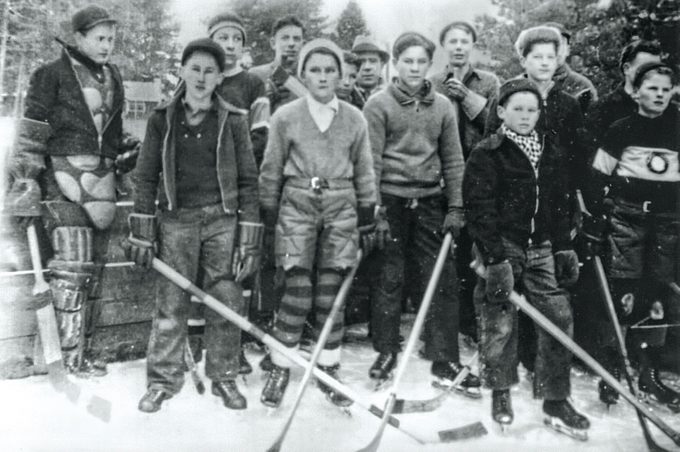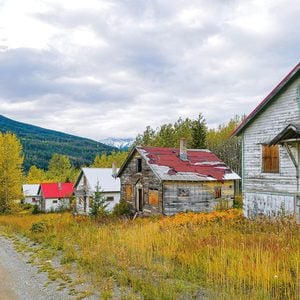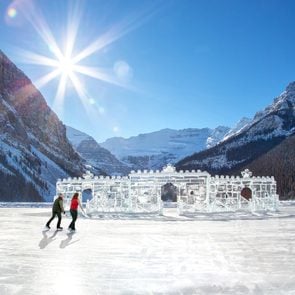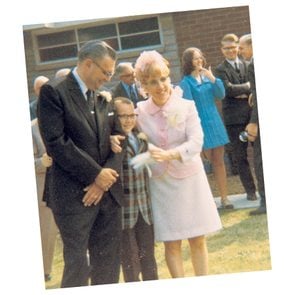Hockey Night in Hedley, B.C.
Fond memories of a small but vibrant town and their love of Canada's favourite pastime.

For the Love of the Game
I grew up in the tiny but mighty (back then) town of Hedley, British Columbia. The town’s two gold mines and two mills drew workers from around the world before, during and after the Great Depression.
Any boy who could skate could join the Hedley scrub hockey team in the late 1930s. With no official coaches, the boys’ abilities improved by playing shinny—not through drill practices. Some of the dads with previous hockey experience, and who showed up in town for mining work, volunteered tips at irregular intervals. Occasionally, even the company superintendent shared his hockey expertise. Other times, the butcher’s helper leaped onto the ice. The boys would shout, “Hey, Syd, show us how to do stuff.” He’d stickhandle, zoom around and shoot past the startled goalie. My brother Donnie would shout, “Hey! When Syd skates backwards, I can’t catch him!”
Syd would reply, “Okay, boys, let’s play the game. They’re fired up now.”
Adult volunteers would take turns refereeing, but they didn’t have to work too hard, as the ice had no blue line, red line, crease line—or any other lines. Any spot was a faceoff spot. Mostly, the referee whistled to signal time, or when the puck arced over the wooden fence. He’d ignore minor infractions. But body checking, checking into the boards, slashing, high sticking and fighting were disallowed because only the goalie, my other brother, Alex, could brag of having padding at company cost. He and a couple of others wore padded gloves. Otherwise, the boys’ uniforms consists of toques, sweaters and knitted mitts, as well as trousers with newspaper stuffed up the pant legs.
When Donnie, a right winger, took a turn at being captain, he goaded his teammates into playing harder and skating faster through any zone—his only offensive strategy.
The rink, of unknown dimensions, was built on a pond partially comprising runoff from the mill, and featured a couple of floodlights. The one penalty box gate opened onto a snowbank, which served as seating. But it was seldom used and there were few injuries because games were weekend “friendlies” with scrub teams and from neighbouring towns.
Family and friends, who attended evening home games without fail, stood ankle-deep in snow at the railings and whooped as loud as any Hockey Night in Canada crowd we’d hear on our static-filled mantle radio. A volunteer stood behind each goal and help up a hand when the puck slid, wobbled or flew into the net. Another volunteer scraped the ice with a makeshift Zamboni made of boards nailed to a two-by-four.
Our team’s trips to surrounding towns, Blackburn, Princeton, Copper Mountain and Keremeos, each no more than an hour’s drive away, were composed of car-pooling dads, the few who could afford a sedan big enough for players to cram into; coupes with rumble seats lose their appeal in sub-zero temperatures.
I recall my friend Finlay’s 1937 Hudson Terraplane with swooping fenders and a bulbous rear end, as well as my dad’s dented Ford with the cracked windshield. Frozen ruts beneath fresh snow showed their true nature when the cars skidded and fishtailed along narrow mountain roads. Flat tires were not unheard of.
The Hedley rink at the town’s heart thrived due to the skaters’ shack. Its worn benches lining the walls appeared plush to tired players and spectators alike. The potbelly heater full of cracking and spitting frost-coated wood warmed noses and toes. Some of the miners who rode the skip into town on weekends enjoyed the banter with rink rats of all ages. There were no flashing scoreboards, twirling towels or thundering music to celebrate our team’s win, just glowing hearts amid the falling snowflakes winking in the lights.
Next, read the heartwarming story of what it was like growing up with hockey in Durham, Ontario.






